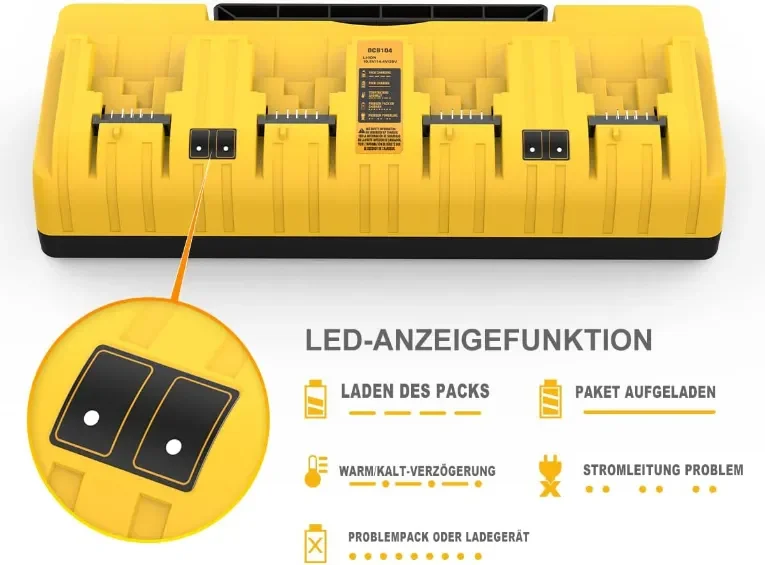How DeWalt Chargers Handle High-Temperature Job Sites
Hot job sites put stress on both chargers and batteries. Smart charger design combined with disciplined on-site practices helps prevent premature failures, extend service life, and lower safety risks. This guide breaks down how DeWalt chargers respond to high heat, what crews should do on sweltering days, how to spot problems early, and how to react if a charger or pack overheats.

How heat affects chargers and batteries — quick recap
-
Charger electronics: Heat accelerates component wear, especially electrolytic capacitors and MOSFETs, and increases the chance of thermal trips that can interrupt workflow.
-
Batteries: Higher cell temps boost charge acceptance briefly, but also speed up chemical degradation and raise the chance of venting or thermal events.
-
Practical thresholds: Treat ~40 °C (104 °F) ambient as the caution zone. If charger or pack surface >45–50 °C, treat it as an immediate red flag.
Always check manufacturer specs for the model in use. These thresholds are field guidelines based on industry practice.
How well-designed chargers protect themselves and packs
Modern DeWalt-class chargers and quality third-party units deploy several overlapping safeguards:
-
Temperature sensing: Thermistors track PCB and bay temps. Many chargers also read pack thermistors to adjust charging profiles.
-
Thermal throttling: Current is reduced when temps climb, slowing the charge but preventing runaway heat.
-
Cutouts and shutdowns: When limits are exceeded, charging halts completely.
-
Bay isolation: Multi-bay chargers operate independently, so one hot pack won’t disable the whole system.
-
Ventilation & heatsinking: Heat spreaders, vents, and sometimes active fans dissipate stress.
-
Soft-start design: Controls inrush current, preventing extra thermal load.
-
Feedback loops: LEDs or logs alert operators to intervene.
Industry insight: These systems are designed for safety margins, but they are not failproof. Relying on protections alone, without operational discipline, is what usually shortens fleet lifespan.
Jobsite checklist — keep chargers healthy in heat
-
Shade & ventilate: Keep chargers out of direct sun and off hot steel decks.
-
Maintain clearance: Leave 10–15 cm (4–6 in) around vents; never stack chargers.
-
Shelter charging stations: Use simple shaded shelters or ventilated cabinets; airflow is more effective than AC in many cases.
-
Stagger cycles: Don’t flood all bays at once — let equipment rest between cycles.
-
Switch to gentle charge: On very hot days, avoid fast mode unless the deadline demands it.
-
Cooldown packs: After intense tool use, let packs sit for 10–20 minutes before charging.
-
Store spares cool: Use shaded trailers or insulated boxes.
-
Post reminders: Keep a laminated checklist near chargers for crews to follow without guesswork.
Monitoring & early warning — practical tools
Crews don’t need complex lab gear. A few simple tools and habits catch trouble early:
| Check Type | Tool / Method | What to Look For | Action if Out of Range |
|---|---|---|---|
| Tactile check | Hand on pack/charger | Hot surface early in cycle | Remove, cooldown, reassess |
| IR thermometer | Pocket IR gun | >45 °C surface | Stop, relocate to shade |
| LED signals | Charger indicators | Temp-wait or fault light | Remove pack, inspect later |
| Charge duration | Clock/tracking | Slower cycles, derating | Investigate charger health |
| Fleet logging | Notebook/app | Temp, pack ID, charger ID | Spot recurring faults |
Field thresholds:
-
Normal: < 40 °C
-
Caution: 40–45 °C (monitor more closely)
-
Critical: > 50 °C (stop use, quarantine)
Quick troubleshooting flow for heat-related issues
-
Temp fault or slowdown: Remove packs, relocate charger to a cooler spot, rest 15–30 minutes.
-
Ventilation check: Clear dust from vents and fans.
-
Isolate the cause: Try suspect packs in a known-good charger, and vice versa.
-
Quarantine overheating packs: Label them and keep aside for later testing.
-
Charger repeat faults: If multiple good packs run hot on one charger, retire or service that charger.
Fleet & procurement policies for hot climates
Fleet managers can prevent downtime by:
-
Specifying ambient rating: Choose chargers rated for >40 °C operation if working in hot climates.
-
Insisting on per-bay thermal control: Ensures scalability and safety.
-
Standardizing SOPs: Require shaded charging areas, daily checks, and cooldown rules.
-
Tracking equipment history: Rotate or retire chargers with repeated thermal shutdowns — they age much faster under heat.
Industry insight: Many companies only react when chargers fail, but data logging and pre-emptive retirement save more money long term than squeezing out “just one more season” from failing units.
Safety & emergency response
-
Immediate: Unplug charger, move overheated pack outdoors to a fire-safe surface, clear the area.
-
If fire or smoke: Evacuate, call emergency services. Only trained staff should attempt suppression.
-
Never open packs: Opening hot or smoking packs is extremely dangerous.
-
Document & quarantine: Record serials, take photos, and arrange recycling or manufacturer return.
FAQ — quick answers
Q: Can chargers sit in a job trailer without AC?
A: Only if temps stay within rated range and ventilation is adequate. In extreme heat, outdoor shaded shelters often perform better.
Q: Will disabling fast charge help?
A: Yes — slower charging produces less heat and is the simplest mitigation.
Q: How often should temps be checked?
A: At least once in the first 5–10 minutes of charging and then hourly in extreme heat.